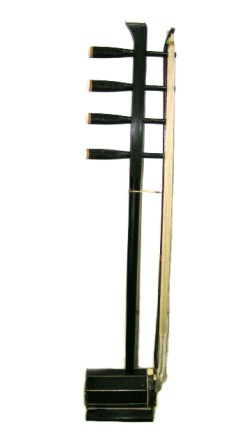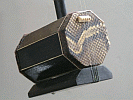 |
||||||||
SiHu (Khuuchir) |
||||||||
 |
The sihu (四胡; pinyin: sìhú) is a Chinese bowed
string instrument with four strings. It is a member of the huqin family
of instruments. The instrument's name comes from the words sì (四, meaning "four" in Chinese, referring to the instrument's number of strings) and hú (胡, short for huqin, the family of instruments of which the sihu is a member). Its soundbox and neck are made from hardwood and the playing end of the soundbox is covered with python, cow, or sheep skin. There are several sizes of sihu; the lowest of these is generally tuned C, C, G, G; the medium size is tuned G, G, D, D; and the smallest size is tuned D, D, A, A. The instrument is held vertically, with its soundbox on the player's lap, and its strings are tuned in pairs. The hair of the bow passes between the two pairs of strings. Four metal strings are arranged in a way that the first and the third strings are in a group. They have the same tuning (in G). The second and the fourth strings are another group. They also have the same tuning (in D). The bow strings are split into two bundles, one between the first and second strings, the other between the third and fourth strings. The playing of khuuchir is similar to that of an erhu. The sihu is primarily associated with the Mongolian culture, who call it a Khuuchir. It is played by Mongolians in Mongolia and also in the Inner Mongolia Autonomous Region of China. It is also used as a traditional instrument in the Liaoning, Jilin, Heilongjiang provinces of China. It is also used as an accompanying instrument in various Chinese narrative genres, including Beijing dagu, plum blossom dagu, xihe dagu, Tianjin new tunes, Shandong qin shu, Northeast dagu, Hubei song, Shaoxing lianhua luo, Shanxi er ren, Inner Mongolia er ren, northeast dance duet, lucky play, Beijing opera derived drama from ballads, Hebei pi ying (shadow theater), and Henan erjiaxian traditional entertainment involving talking, singing, and drama. Similar instruments include the Mongolian dörvön chikhtei khuur and the Tuvan byzaanchy. Information extracts reproduced from Wikipedia under 'Collective Commons License' http://en.wikipedia.org/wiki/Sihu Sound and Image source: http://www.s-o-n.net/sihu01.htm who also provided the pairing arrangement of the strings |
|||||||
|
||||||||
|
||||||||


